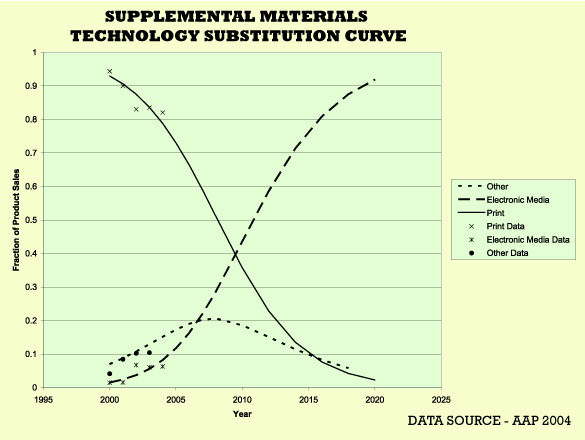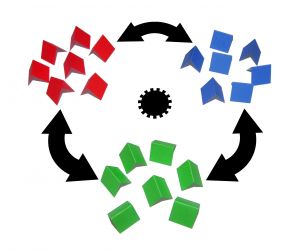Textbooks and Education Technology are changing in disruptive and dramatic ways. Technology substitution is driving a great deal of this change. The recent sale of Harcourt’s various divisions to Pearson and Houghton/Riverdeep is only the tip of the iceberg. Education Publishers of print and technology products, large and small, are all wrestling with these changes.
 The changes are affecting every aspect of our business including how products are created, priced, sold, packaged, promoted, and even what the basic definition of a product is. I believe these changes are only beginning and that they will accelerate in the next several years. Anecdotal evidence includes attendance at shows like the recent IRA (empty) and NECC (swamped). Sales of electronic whiteboards (Promethean, Smart, RM) are skyrocketing. Pearson swept the California Social Studies adoption with a hybrid technology and print product.
The changes are affecting every aspect of our business including how products are created, priced, sold, packaged, promoted, and even what the basic definition of a product is. I believe these changes are only beginning and that they will accelerate in the next several years. Anecdotal evidence includes attendance at shows like the recent IRA (empty) and NECC (swamped). Sales of electronic whiteboards (Promethean, Smart, RM) are skyrocketing. Pearson swept the California Social Studies adoption with a hybrid technology and print product.
We ain’t seen nothin’ yet.
A Quantitative View
 There is a more quantitative way to study this change. Over the next few days we will be publishing a study done by Paul Schumann a futurist and business analyst who has studied the sources and rate of change across many industries at IBM and as an independent consultant at Glocal Vantage. He has taken a detailed look at the Education Market and his findings have profound implications for where our industry is headed. Paul has published another version of this study on his blog Innovation Travelogue.
There is a more quantitative way to study this change. Over the next few days we will be publishing a study done by Paul Schumann a futurist and business analyst who has studied the sources and rate of change across many industries at IBM and as an independent consultant at Glocal Vantage. He has taken a detailed look at the Education Market and his findings have profound implications for where our industry is headed. Paul has published another version of this study on his blog Innovation Travelogue.
Paul’s analysis is a quantitative tour through what we can expect in the coming years. The punch line is that we are at the beginning of the product substitution shown in the chart below. Don’t discount the dramatic nature of this prediction. When disruptive technologies hit an industry the change often sneaks up on the unprepared and is largely over before there is time to react. Consider the tale of print encyclopedia’s which saw the value of their products plummet from over $2,000 to under $5 in a 3 year period in the 1990’s when CD-ROM based products were bundled with other software.

Here is a small sample from the report:
“One of the interesting, and most insidious aspects of this type of substitution, when the substitution is taking place in a growing market, is that a large percentage of the substitution has taken place before the old technology sees two successive years of decreased revenue. This is the case [in Reference Libraries]. Fifty percent of the total time to 90% substitution has elapsed before the print media have experienced two years decline”
Think about that.
Other Articles in this Series
Introduction
Part 1 – Reference Libraries and Open Source
Part 3 – Conclusions & Recommendations
Below the fold a bio of Paul Schumman






 It got a nice review on John Rice’s
It got a nice review on John Rice’s  First off, I find it interesting that Second Life is getting most of the visibility in Education when other virtual worlds (Habbo Hotel, Whyville, etc.) are doing far more with K12 age kids and some have more intentionally educational content on them. Chalk it up to Second Life being a media darling and to good outreach from their Education team. If you are interested in this arena some of these other worlds merit a look.
First off, I find it interesting that Second Life is getting most of the visibility in Education when other virtual worlds (Habbo Hotel, Whyville, etc.) are doing far more with K12 age kids and some have more intentionally educational content on them. Chalk it up to Second Life being a media darling and to good outreach from their Education team. If you are interested in this arena some of these other worlds merit a look. Breaking down artificial boundaries in the world of Education emerged as a theme today at
Breaking down artificial boundaries in the world of Education emerged as a theme today at  This thread was picked up early in the afternoon by panelist Jackson Grayson from the
This thread was picked up early in the afternoon by panelist Jackson Grayson from the  The panel on Managing Influencers at the Austin Game Developers Conference yesterday got me thinking about a frequently ignored aspect of the K12 publishing world – building and nurturing communities of key influencers around education products.
The panel on Managing Influencers at the Austin Game Developers Conference yesterday got me thinking about a frequently ignored aspect of the K12 publishing world – building and nurturing communities of key influencers around education products.